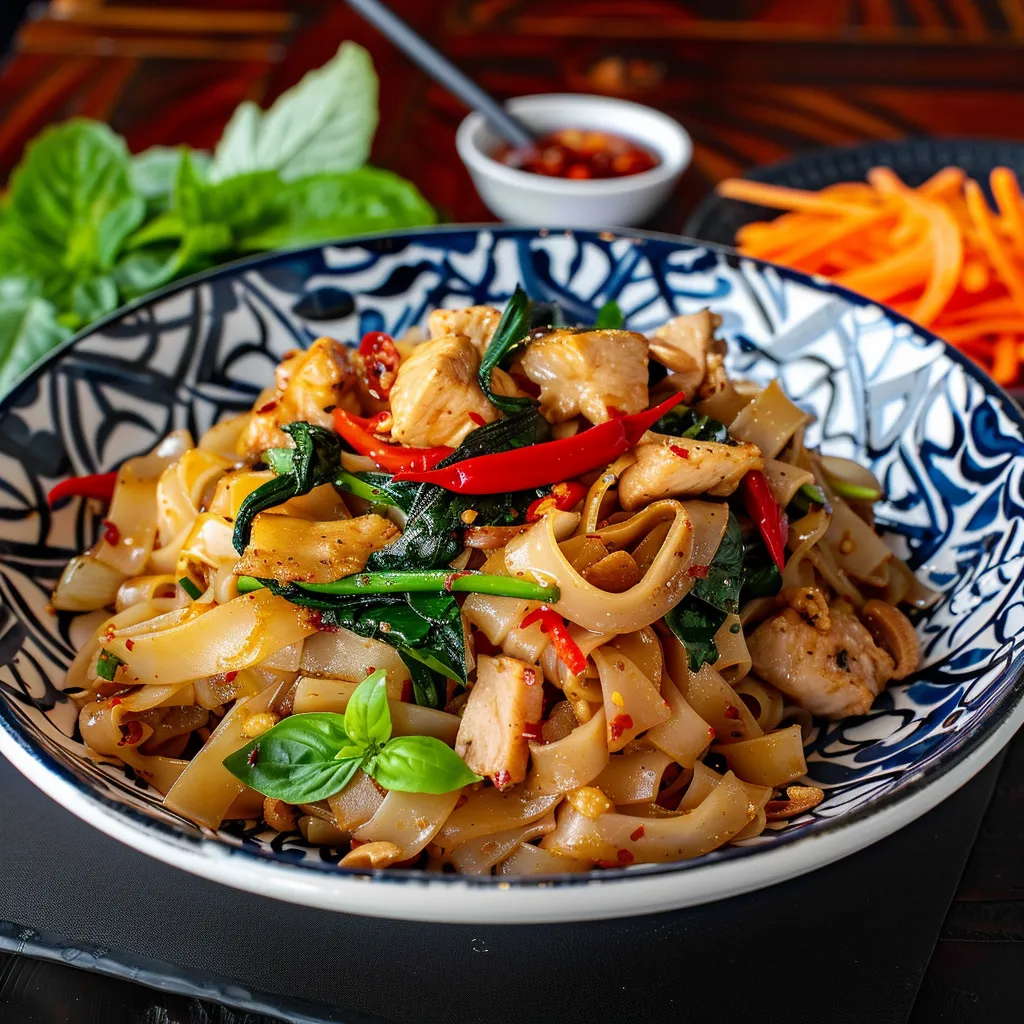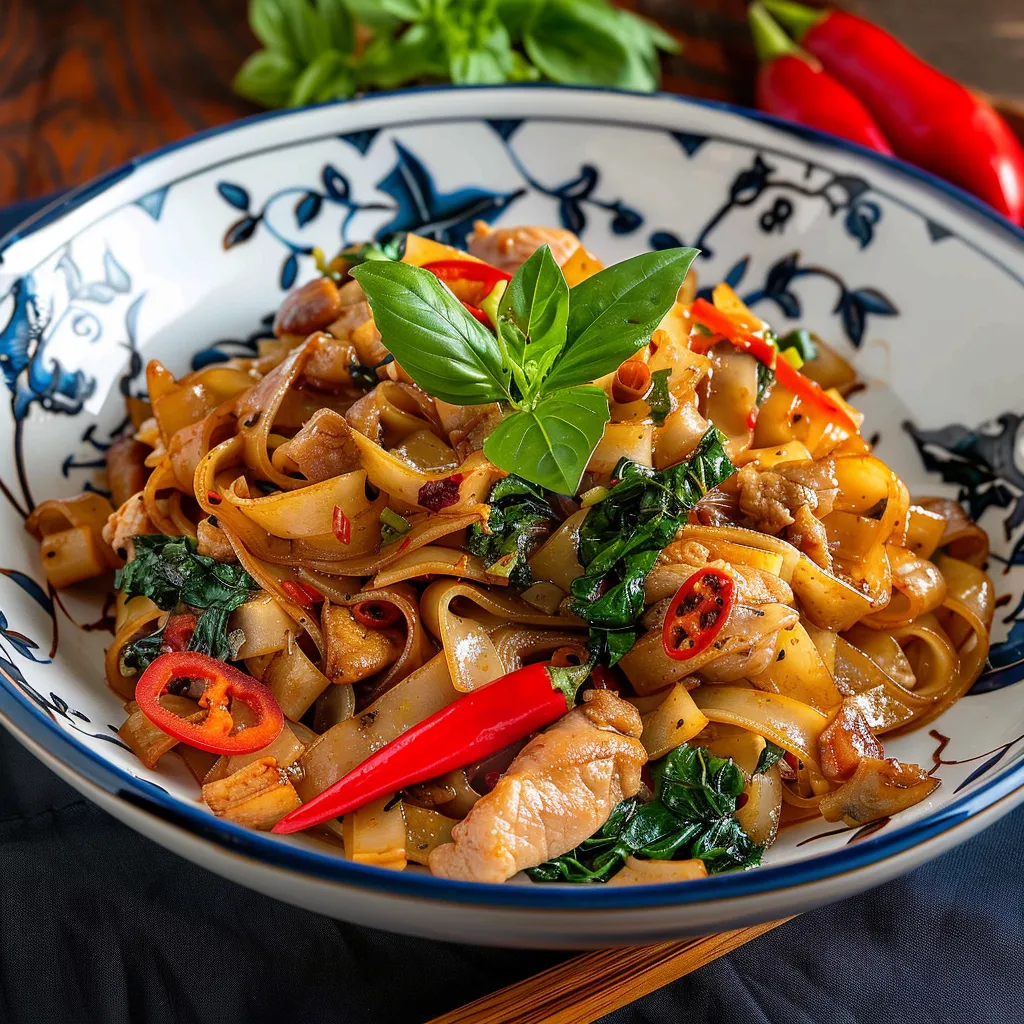 Pin to Favorites
Pin to Favorites
Authentic Thai Drunken Noodles offer a thrilling combination of chewy fresh rice noodles, bold savory sauce, fragrant holy basil, and fiery chilies that create an unforgettable taste experience. Known in Thailand as Pad Kee Mao (ผัดขี้เมา), this beloved street food dish delivers complex flavors that somehow manage to be comforting yet exciting with every bite. The slight char on the noodles adds a subtle smokiness that, combined with the aromatic herbs and perfectly balanced sauce, creates something truly extraordinary.
Last month I prepared this for a dinner gathering where several guests claimed they 'don't really like spicy food.' To my delight, every plate was cleaned, and my neighbor even asked for the recipe before leaving. The key was balancing the chilies to create flavor without excessive heat and allowing those noodles to develop that authentic char that makes restaurant versions so irresistible.
Essential Ingredients and Selection Tips
- Fresh Rice Noodles: These wide, flat, chewy noodles (also called ho fun) are crucial for authentic texture. Look for them in the refrigerated section of Asian markets.
- Holy Basil: This distinctive herb has a unique peppery, clove-like flavor. If unavailable, Italian basil is actually a better substitute than Thai basil.
- Chilies: The combination of fiery Thai chilies and milder spur chilies creates depth of flavor.
- Golden Mountain Sauce: This Thai seasoning sauce adds umami depth. Maggi Seasoning makes a good substitute, or you can increase the soy sauce slightly.
 Pin to Favorites
Pin to Favorites
Detailed Cooking Instructions
- Step 1: Prepare Fresh Noodles
- Separate fresh rice noodles gently. If refrigerated, microwave for 30-45 seconds or briefly steam to soften. Cut into 2-inch wide strips.
- Step 2: Make Chili-Garlic Paste
- Pound Thai chilies, milder red chilies, and garlic into a rough paste using a mortar and pestle. If unavailable, finely chop and crush with a knife.
- Step 3: Cook the Protein
- Heat a wok over high heat, cook shrimp (1 min per side) or chicken/pork/beef (2-3 min) until just done. Set aside.
- Step 4: Build the Flavor Base
- Add oil to the wok, stir-fry chili-garlic paste for 15-20 seconds, then add firm vegetables (e.g., carrot, Chinese broccoli stems).
- Step 5: Char the Noodles
- Add fresh rice noodles, pour in sauce (soy sauce, Golden Mountain sauce, oyster sauce, fish sauce), and sprinkle sugar. Let noodles char for 30-45 seconds before folding. Repeat 2-3 times.
- Step 6: Add Herbs and Protein
- Once noodles have developed charred spots, toss in Chinese broccoli leaves and holy basil. Stir just until wilted. Return protein to the wok and fold gently.
- Step 7: Serve Immediately
- Transfer noodles directly from the wok to a plate and serve immediately for the best flavor and texture.
My first attempts at this dish resulted in broken noodles and inconsistent sauce distribution until I learned to use the gentle folding technique instead of aggressive stirring. This simple change made all the difference in maintaining the integrity of those beautiful wide noodles.
The distinctive smoky flavor in authentic drunken noodles comes from allowing the noodles to develop a slight char against the hot wok. I've found that patience is key here—resist the urge to constantly stir, and instead let the noodles sit undisturbed for brief periods.
Fresh Noodle Handling Secrets
Fresh rice noodles can be challenging to work with due to their tendency to stick together. A light coating of neutral oil on your hands can help separate them easily.
If you can’t find fresh rice noodles, dried wide rice noodles can be used. Soak in room temperature water until pliable (30-40 minutes), then briefly boil until just before al dente.
Balancing Heat Levels
The beauty of making drunken noodles at home is controlling the spice level while maintaining authentic flavor. If reducing Thai chilies for less heat, keep the milder chilies for depth of flavor.
For guests with varied spice tolerances, prepare the base recipe mildly spicy and serve fresh sliced chilies in fish sauce (prik nam pla) on the side.
I've refined these techniques through countless attempts, including one memorable dinner party where I tried cooking multiple portions at once. The noodles steamed rather than charred, creating a completely different dish. Now I happily take the extra few minutes to cook each portion individually, knowing the results are worth it.
The journey to mastering this iconic Thai street food has given me a deep appreciation for the careful balance of techniques and ingredients that make it so special. There's something deeply satisfying about creating these authentic flavors at home, watching the noodles take on that beautiful char, and experiencing the explosion of aromatic herbs, chilies, and savory sauce in each bite. When friends taste it for the first time, their eyes widening with pleasure tells me everything I need to know—some dishes are worth the extra effort, and drunken noodles is definitely one of them.
 Pin to Favorites
Pin to Favorites
Frequently Asked Questions
- → Can I use dried rice noodles instead of fresh ones?
- Yes, you can use dried wide rice noodles, though the texture won't be quite the same. You'll need about 6oz of dry noodles, which should be soaked, boiled, and rinsed in cold water before stir-frying.
- → What can I substitute for holy basil?
- Regular Italian basil makes a fine substitute for holy basil if you can't find it. The flavor will be slightly different but still delicious.
- → Why is it recommended to cook one portion at a time?
- Cooking one portion at a time ensures that your wok stays hot enough to properly char the noodles and creates that authentic street food flavor. It also prevents overcrowding which can make the noodles soggy.
- → What protein works best in Pad Kee Mao?
- This recipe is versatile and works well with chicken, pork, beef, shrimp, or tofu. If using meat, slice it thinly and consider a brief marinade in soy sauce, sugar and water for extra flavor.
- → How spicy is this Pad Kee Mao recipe?
- The spice level is customizable based on how many Thai chilies you add. For mild heat, use just one chili; for authentic Thai spiciness, use three or more. You can always adjust to your preference.
